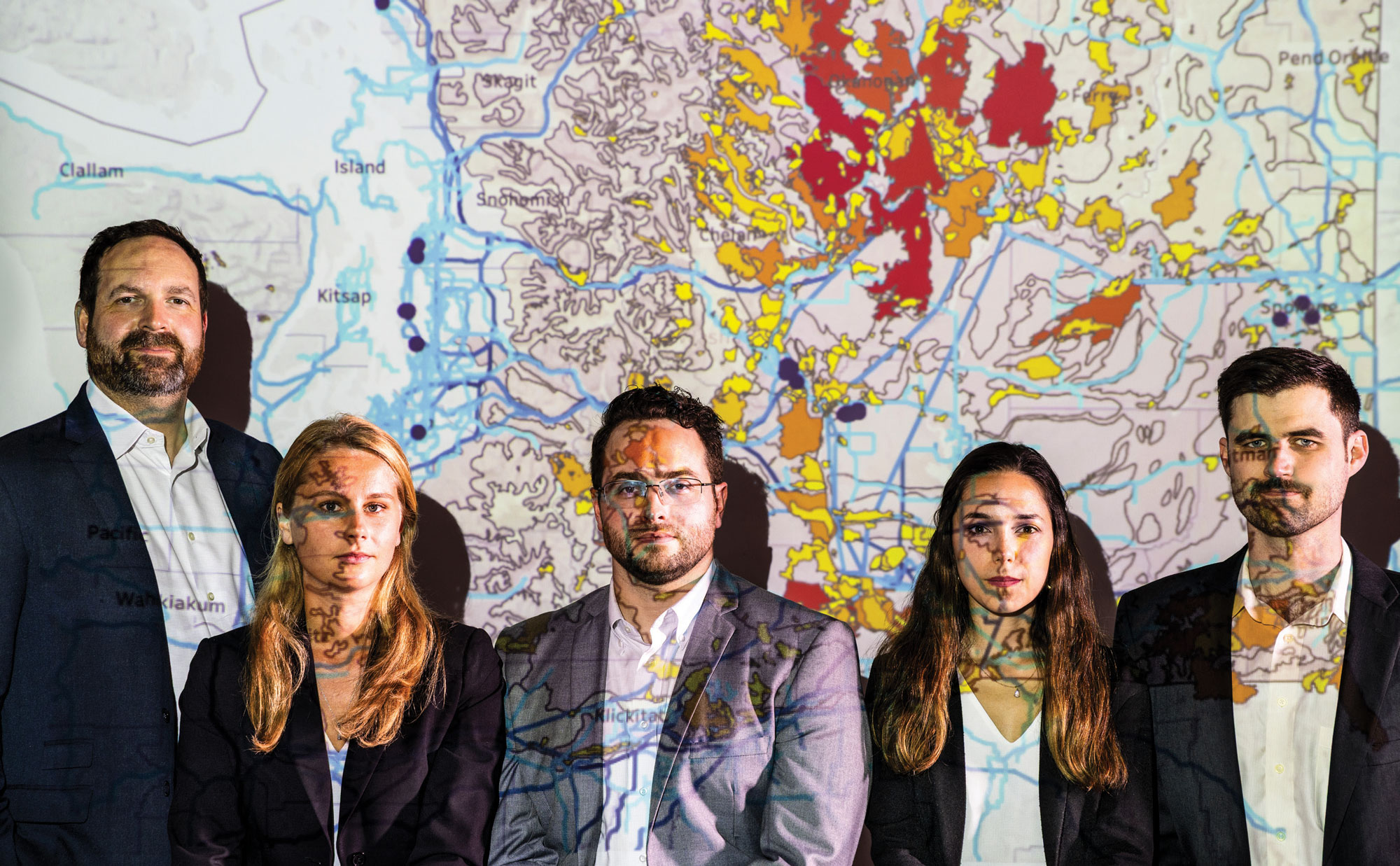

Severe storms. Rising temperature. Floods. Catastrophic weather events like these cause havoc for people and communities—as well as for business and the economy. They can impact everything from the global supply chain to an employee's ability to get to work, and many companies simply aren't ready to deal with the fallout. But a group of students from the University of Washington's Foster School of Business is learning how to help companies better weather the storm, figuratively and literally.
In the UW Climate Risk Lab, Foster undergraduate and graduate students learn how extreme, costly weather events might affect businesses—and what businesses can do about it. Last spring, for example, MBA candidates Joe Garan, Anna Kemmerer, Monica Kunzel and Spenser McDonald spent 10 weeks acting as consultants, analyzing how likely it was that wildfires would disrupt Amazon’s facilities in Washington state, and developing recommendations to make the company more resilient to climate risk.
The students examined Amazon’s supply chain details, the region’s public services and safeguards, and fire forecasting data from the Climate Risk Lab’s wiki—an open-source community where researchers can keep data current and aggregate this important information for free public use. Combining these resources, the student team was able to forecast how wildfires might affect the operations of an Amazon facility: Will power or water be turned off? Will highways be shut down? Will employees be able to make it into work?
The Climate Risk Lab is led by Professor Phillip Bruner, ’05, who joined the UW faculty in 2023, when the lab was little more than an idea. He brought extensive experience helping worldwide businesses incorporate mapping data into their financial decisions, and that expertise gave him the tools to turn the lab into its current reality. It’s a cross-campus initiative to compile data on climate-related risks—for example, heat maps of potential wildfire zones—and provide access, analysis and tools for anyone to use.
The wiki was launched in May and funded by a $500,000 gift from Amazon. Bruner teaches students how to apply the valuable information it contains, calculating climate risk for real-world scenarios at data centers, on tribal lands, in real estate and beyond. By making this information publicly available and at zero cost, Bruner hopes to enable other businesses to plan for their future, for the good of communities and the economy.
“A lot of my students have climate anxiety. But they're looking for practical solutions and to tackle climate risks specific to each industry.”
Phillip Bruner, UW Climate Risk Lab
“We have a very good understanding of the climate science,” Bruner says, “but not how to translate that data into dollars.” He credits the UW with being the kind of innovative, interdisciplinary institution where it makes sense to try out a relatively new idea, like taking climate risk beyond the realm of scientists and teaching it to business students. In building out the Climate Risk Lab, Bruner formed a cross-campus steering committee including professors Jan Whittington of the College of Built Environments, Kristie Ebi of the School of Public Health and Dale Durran of the College of the Environment. A team of interns from the College of Engineering helped build the wiki, which grew in scope and sophistication with the addition of three full-time staff members hired last summer with Amazon’s financial support.
The need for a generation equipped with data-driven climate solutions has become clear. Forty years ago, U.S. weather- related disasters like hurricanes or floods that caused over a billion dollars in damage (in today’s currency) would happen every 16 weeks, according to the Fifth National Climate Assessment, a report on climate change impact conducted in 2023 by the U.S. Global Change Research Program. Today, a similarly expensive disaster happens about every three weeks. The National Oceanic and Atmospheric Administration reports that in 2024 there were 27 climate- related disasters costing more than $1 billion each. (That number will no longer be calculated in the current administration.)
Bruner says there’s more student interest in working on lab projects than his team has capacity to manage. “We’re seeing a significant amount of passion and interest in tackling this problem through business, and a willingness to engage with the material, which is inherently complex,” he says. “A lot of my students have climate anxiety. But they’re looking for practical solutions and to tackle climate risks specific to each industry.” It helps, he notes, that the program puts these students and their creative solutions in front of potential employers.
Student Joe Garan, who graduated in June, emphasizes that climate risk is not “some distant, abstract problem reserved for the world of environmentalists and scientists.” He says, “No matter the industry, strategy or value proposition of a business, they need to consider the changing climate as they predict and plan for the future. Business students shouldn’t see this as just valuable, but as critical to their skill set.”
Learn more about the Climate Risk Lab.